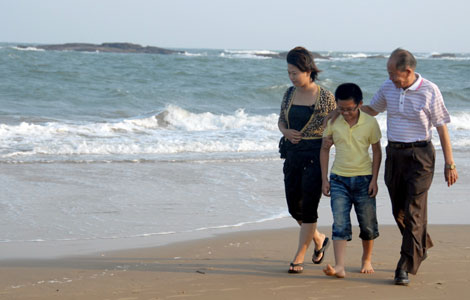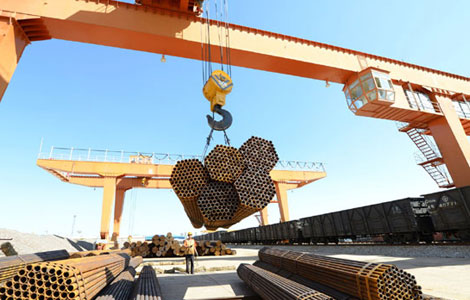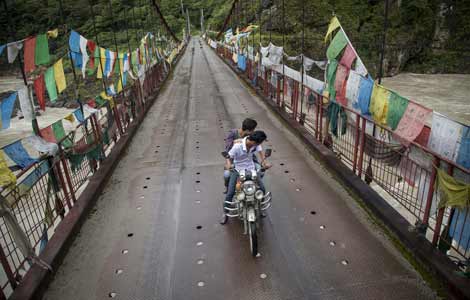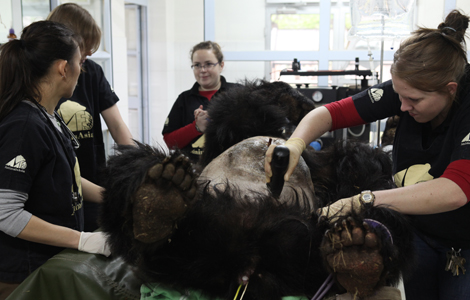Bring back blue sky and white clouds
Updated: 2013-08-09 12:15
By Chen Weihua (China Daily)
|
||||||||
I spent the last weekend touring the Washington National Arboretum where a China Garden is expected to be built, and I also visited the Mormon temple in Kensington, Maryland, whose sky-piercing spires I see driving into Washington on the Capital Beltway.
From various angles, we took photos of the Capitol Columns in the arboretum and the golden spires at the temple. However, we found ourselves distracted by something in the background: fluffy white clouds and blue sky. It's something so common in Washington yet so rare for those of us from Shanghai and Beijing.
Increasingly, Chinese visitors to the US no longer feel awed by the skyscrapers in New York and the Metro tunnels which go so deep underground in DC. Shanghai's skyscrapers are now taller. Last week, Shanghai Tower, which will be 632 meters (2,073 feet) high and have 121 stories, was topped off. It will be the second-tallest in the world when completed next year, surpassed only by the Burj Khalifa in Dubai, United Arab Emirates.
Beijing and Shanghai both have extensive subway systems, mostly built in a short time span before the 2008 Beijing Olympic Games and the 2010 Shanghai Expo. They are already the longest in the world, out-distancing the much older ones in Moscow, London and New York.
However, whether you look out from the skyscrapers in Shanghai's Lujiazui, or exit a subway stop along Chang'an Avenue in Beijing, you will never see the kind of blue sky and white clouds I encountered last weekend. In fact, I rarely remember seeing a bright sun in Beijing - even just once. It's always shrouded in a hazy sky, "like a "salty egg yolk", I like to tell Beijingers.
While China's rapid modernization in the past more than three decades has narrowed many of the gaps with the developed world, the environmental gap has widened sharply.
Before China's reform and opening-up in the late 1970s, the country was an economy of scarcity. Many items, such as cloth, were rationed. Now China supplies the world with a dazzling array of manufactured goods and Chinese-made garments clothe the world.
But what's in scarcity is the blue sky and white clouds that we marveled at last weekend, and which almost every day allow me to see far beyond the Connecticut Avenue Bridge near my apartment.
What China needs is clean air, soil and water. That is a deficit we cannot afford to ignore.
Polluting the environment - whether air, soil or water - has been the least costly thing to do in China in past decades. Many individuals spit and litter; many factories discharge sewage and toxic waste into the environment.
Everyone in China is richer now and there are many billionaires. But the cost of getting there has been excessively high, so high that our children, grandchildren and great-grandchildren will continue to pay back long after our passing.
The good news is that China has finally realized that its growth model of the past three decades is not sustainable because of its huge impact on the environment. Premier Li Keqiang has stressed the "ecological civilization" in moving up the economic value chain.
The colossal challenge China faces on the environmental and ecological front is unmatched by any other challenge, such as a real estate bubble, unemployment or even corruption, all of which are thorny.
In most of China, environmental laws are still not enforced effectively enough so that no individual or business dares to try their luck any more.
If we don't mean business in solving the environmental crisis, we will never see that blue sky and those fluffy white clouds in cities across China.
The author, based in Washington, is deputy editor of China Daily USA. E-mail: chenweihua@chinadailyusa.com
(China Daily USA 08/09/2013 page15)
Most Viewed
Editor's Picks

|

|

|

|

|

|
Today's Top News
Pharm giant says it takes bribery claims 'seriously'
China's inflation rises 2.7% in July
Budget show cuts in provincial spending
US realty market 'connects dots' with China buyers
Pharm giant suspected of bribery
Economic prospects improved
Beijing rejects protest over patrol
China Unicom tests 4G network
US Weekly

|

|












